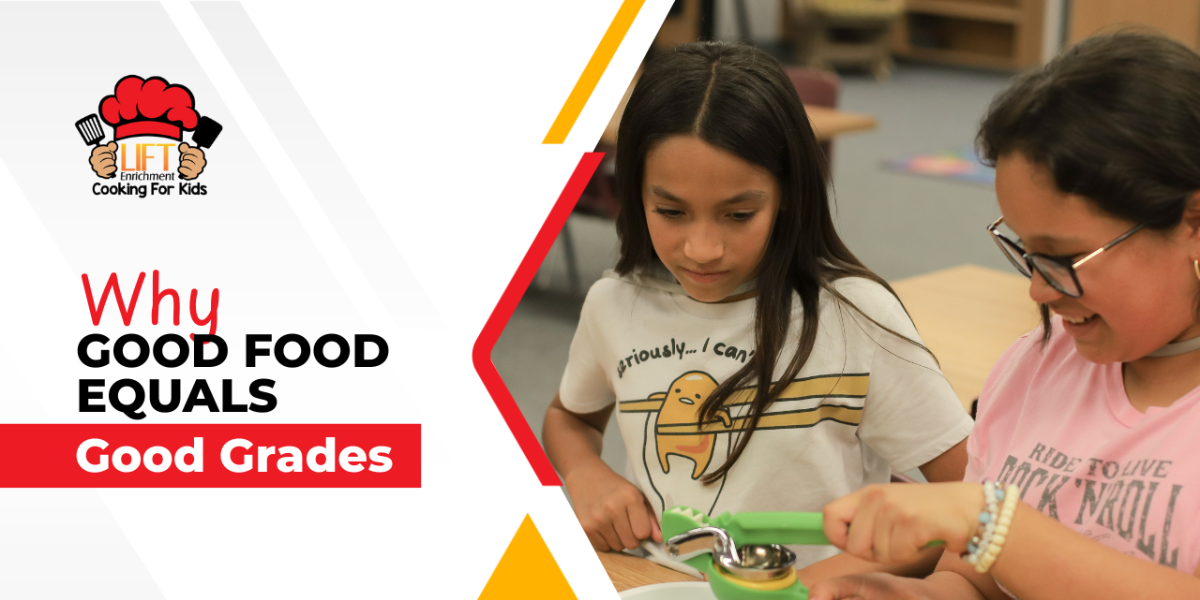There’s a saying in the wellness world: you can’t “out-learn” a bad diet. In education, that same saying can also be applied. Meaning, even with great teachers and fun lessons, it’s hard for kids to focus and learn well if they’re not getting the right fuel from their food.
At LIFT Enrichment, we’ve seen the same truth again and again: When kids start eating real, nourishing food, everything changes. Focus improves. Moods level out. Learning takes off.
Case in point…
The New York Diet Experiment
Back in the 70s, a PhD called Stephen Schoenthaler managed to get funding for a pretty bold experiment: Would changing the food at underperforming New York public schools make their CAT scores go up?
To find out, he took 803 public schools that ranked “below average” in CAT scores. (As a group, they were in the 39th percentile, a score that hadn’t moved in a long, long time). Then, over four years, he made their breakfasts and lunches healthier.
How?
- In Year 1, he got rid of all high-sugar foods and 2 artificial food colorings.
- In Year 2, he got rid of ALL food coloring.
- He didn’t change in Year 3.
- In Year 4, he removed foods that contained the preservatives BHT and BHA.
So, not very drastic.
He merely reduced the consumption of sugar, food colorings, and preservatives. (Also, this was 1979, when high-fructose corn syrup and trans fats weren’t as big).
Did it work?
Well, in year 1, CAT scores jumped by 8.1. In year 2, they went up by 3.8. The third year, when he made no changes, saw them remain unchanged. And in year 4, they jumped another 3.7 points.
By the end?
CAT scores for a million NY school kids rose by 15.7 points, taking the schools from the below-average 39th percentile to the above-average 54.9th percentile.
There were no alterations made to the teaching methods or drastic dietary changes implemented. Instead, we should focus on making minor adjustments to promote healthier eating habits.
The brain that builds itself
Why would food be empowered to change CAT scores?
The big reason: the brain.
For example, did you know that the brain is 60% fat? It’s true.
This means that to grow, repair, and function properly (for example, to ace CAT tests, pay attention in class, or remember which year Christopher Columbus crossed the Atlantic), the brain needs a steady supply of fats. But here’s the thing: the brain is a bit like a cash-strapped builder; it’ll use whatever materials you give it to build with.
If a child’s brain only receives hydrogenated oils and trans fats, what will it use? That’s what it uses. Likewise, if a brain gets natural, healthy fats from things like olive oil, fish, cheese, nuts, butter, avocado, and coconut, that’s what’ll make its “building blocks.”
Put simply: The most important organ for kids’ learning, their brain, changes depending on the food they’re feeding it with!
The “Goldilocks” zone of focus
What’s the #1 skill a child needs to learn in class?
Patience? Grit? Intelligence?
We’d argue that before all that comes focus. You can have the best lesson plan in the world, but if kids can’t focus on what you’re saying, they won’t learn.
But here’s the thing:
Focus is hard!
To explain why, imagine you’re shooting a free throw in the NBA final. To succeed, your brain needs to be in what coaches call an “optimum state of arousal.” If you’re not excited enough, that’s not good, but if you’re too excited, that’s also not good. Instead, there’s a “Goldilocks” zone in between where focus happens.
Applied to the classroom:
Kids learn best in the focused zone between “too tired” and “hyper.”
Now, what’s the easiest way to make sure kids’ brains never get a chance to enter this Goldilocks zone?
Very simple:
Sugar.
A kid eats a lot of sugar, and wham! They’re hyper. Then 20 minutes later, whoosh! As their blood sugar crashes, so does their energy. When kids eat loads of sugar, their brains can’t enter the Goldilocks state of focus they need to learn.
To create successful, joyful, well-adjusted children, we need excellent teachers. But in order for kids to learn from excellent teachers, kids need to eat healthy, brain-friendly diets. And that’s the goal of our after-school cooking classes:
To teach kids how easy and fun it is to do so.
As Susie Stangis from Hyde Park Elementary told us after our cooking workshop in her school,
“The students loved it! They’re excited to try new foods, and it’s helping them build healthy habits early on. This experience has taught them the skills they need to make healthier food choices and understand the importance of nutrition.”
We try to make our programs as hassle-free as possible—we bring the chef and all the equipment. All you need is a classroom.
If you’d like to sign your school up or speak with one of our team members about the cooking after-school program, you can book a call with us here.
Previous Newsletters:
To change kids’ lives, start by changing their diets, Big Ways Afterschool Programs Support Title 1 Students, Chef Teacher Story: Meet Chef Scotty, April In Review: Big Wins, Big Growth
